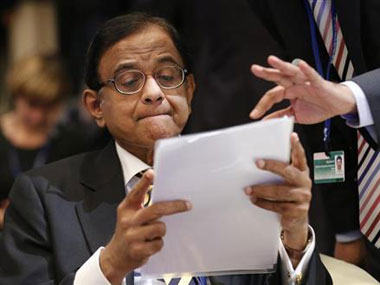The new GDP series, computed on the basis of gross value added (GVA) and market prices instead of factor cost, has had few takers. Reason: the high growth numbers it put out for 2013-14 (6.9 percent) did not accord with the reality of slow industrial growth, weak corporate profitability, and huge bad loans in the banking system, etc. In the words of economist Surjit Bhalla, it did not pass the “smell test.” The Chief Economic Advisor, Arvind Subramanian, didn’t believe it, saying it was “puzzling” how GDP could have grown so fast in a difficult year. Nor did Reserve Bank of India Governor Raghuram Rajan. If he did, he would not have cut interest rates in March. If the economy is chugging along fine, rate cuts can hardly be seen as vital to revival. [caption id=“attachment_2195373” align=“alignleft” width=“380” class=" “]  Former Union Finance Minister P Chidambaram. Agencies[/caption] Only former Finance Minister P Chidambaram was quick to embrace it, for it suddenly showed the UPA’s GDP performance at a panther-like 6.9 percent instead of the buffalo-ish pace of 4.7 percent – which the earlier GDP series had indicated. Soon after the new series was unveiled in January 2015, Chidambaram was busy claiming credit for it. The Economic Times quoted him as saying: “I am happy that the government has released the revised GDP data. It should put an end, once and for all time, to the misconceived charge that the UPA government had mismanaged the economy.” He might have to eat his words when the figures are revised in due course with newer data. A Business Standard story today (13 April) offers clues about why the new series stinks: the Central Statistics Office (CSO) may have made a fundamental error by making extrapolations about GVA based on just 3,00,000 companies when the number of active companies in the country is three times as large – at around 9,00,000. This means when the figures for 2013-14 GDP are revised once the data for all 9,00,000 companies are in (or at least the 5,00,000 in the ministry of company affairs’ database), the growth figure may be brought down. The only way the data can be right is if the GVA of the 2,00,000 companies whose results were unavailable, and the 4,00,000 that were not even in the database, was growing at the same pace as the 3,00,000 that the CSO had in its possession. This is an impossibility. In all probability, thus, the CSE is likely to revise the GDP figures for 2013-14 – most probably sharply downwards. According to the BS story, apparently the CSO found that the paid-up capital of the 5,00,000 companies in the ministry’s e-database constituted 85 percent of the total paid-up capital of the active 9,00,000 companies in the country. So, in order to estimate the growth of the entire 9,00,000 from a database of just 5,00,000, it “scaled up” the overall GVA numbers by 15 percent. A debatable idea, but the real goof-up – or the bigger assumptive leap – happened because 2013-14 saw a double scale-up for even lesser data. It seems only 3,00,000 companies had reported numbers for 2013-14 by October 2014, and since November was the cut-off date for estimating their GVA, the figures for 9,00,000 companies were proportionately expanded from core data for only 3,00,000 companies. In theory, there is nothing scandalous in it. Macro data are always provisional and subject to change as more details become available. Whether it is WPI or CPI or IIP, the final figures usually vary a bit here and there. But the new GDP number for 2013-14 may see a wilder swing, given the nature of the extrapolations involved. In the case of 2013-14 data, the bigger and more solid companies may have gotten their figures into the ministry’s database on time, while the laggards – probably smaller and less profitable companies – may have been excluded. The CSO is thus likely to have over-estimated corporate GVA for 2013-14. So be warned: GDP for 2013-14 may well come down with a thud.
Few economists believed the new GDP data which showed tigerish GDP growth of 6.9 percent in 2013-14. It now seems that there could have been a goof-up where corporate value-added data may have been overestimated
Advertisement
End of Article
Written by R Jagannathan
R Jagannathan is the Editor-in-Chief of Firstpost. see more


)

)
)
)
)
)
)
)
)



